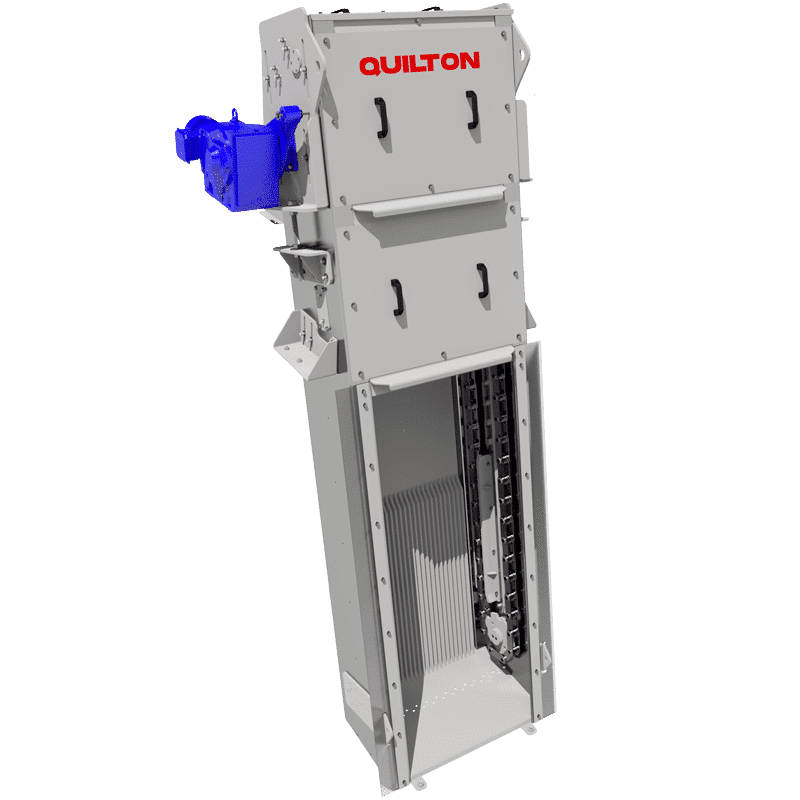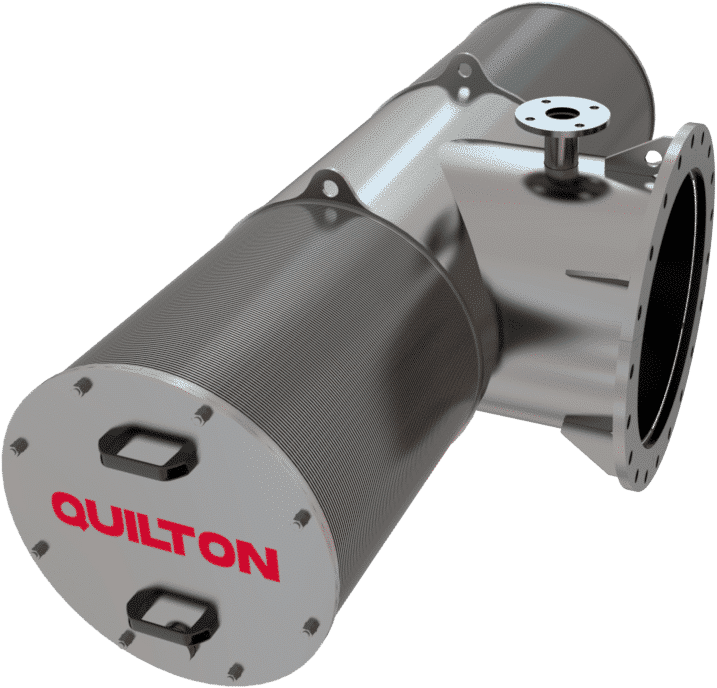This website uses cookies so that we can provide you with the best user experience possible. Cookie information is stored in your browser and performs functions such as recognising you when you return to our website and helping our team to understand which sections of the website you find most interesting and useful.
Self-cleaning continuous band screen

Screens
The QUILTON self-cleaning continuous band screen is remarkable because of its screening capacity, its unique self-cleaning system, and its high performance in both continuous and intermittent operation. Its adaptability to new and existing channels, its efficient self-cleaning of the screen, and its minimal maintenance requirements make this screen the solution to numerous problems at facilities, and it is ideally suited to a wide range of applications.
The QUILTON self-cleaning continuous band screen is fitted directly inside the channel and any solids in suspension in the water are separated, removed and discharged over the lip of the channel. Its self-cleaning system simply involves the movement of the screen, without requiring a continuous high-pressure water supply. This self-cleaning ensures it operates effectively, without supervision and with minimal maintenance.
Features and structure
The design of the QUILTON automatic, self-cleaning continuous band screen combines a filtering system with a self-cleaning arrangement, which permits the automatic removal of floating and suspended materials in a liquid flow for the roughing of fine particles. The largest materials it can remove range from a diameter of 70 mm with the Q100 models, to 180 mm with Q200 models.
The self-cleaning continuous band screen without a main shaft, of up to 2 m in width, is a fine filter composed of teeth or filtering elements mounted on a twin shaft and moved by stainless-steel drive belts on the sides. Its self-cleaning arrangement means that it can always present a clean screen to the oncoming flow of liquid.
The design of the teeth and their assembly on the screen filter provide two filtering stages, determine the size of the solid to be removed, and define the spacing on the screen.
QUILTON screens are self-cleaning simply through the effect of the screen’s movement. This means the teeth make a double movement due to the arrangement of each tooth’s assembly and the positioning of each row of teeth on two consecutive shafts and the screen’s rotation:
- Forward: for offloading the solids extracted.
- Backward: for cleaning the teeth individually and the screen as a whole.
Amongst other advantages, QUILTON equipment is characterized by the following:
- Robust, stable structure involving the interconnection of two side pieces. This design concept means it can adapt to new or existing channels.
- Screen filter moved by drive belts located on the sides of the equipment.
- The belt is preassembled with a bushing that allows for the axial displacement of the screen shafts by an operator during maintenance. This set-up for the belt maximises the screen’s useful life and minimises operating and maintenance times.
- A QUILTON belt undergoes a special treatment that strengthens it and it improves its resistance to corrosion. This treatment reduces wear and stretching, prolonging its useful life.
- Reinforced guiderails for increasing its useful life and minimising maintenance costs.
- Filtering elements mounted in rows forming the continuous band screen. QUILTON’s manufacturing methods allow minimising stresses, increasing the parts’ strength.
- Gear motors made by leading brands to ensure the equipment provides a high performance and low consumption.
- Surface treatment of the structure and drive system to avoid rusting, and so prolong the useful life of the individual components.
Structural features of the self-cleaning continuous band screen:
- Simple, robust design.
- Chassis thicknesses of between 5 and 10 mm.
- Quality of materials: stainless steel AISI 304, AISI 316, duplex 2205, super duplex 2507, etc.
- Adaptability to existing channels.
- Discharge height up to 20 m.
- Strong filtering elements made of ABS or other special materials.
Operation
- Very high solid retention and removal (high screening capacity).
- Depending on the application, it does not require the prior use of a mesh for large solids.
- Double filtering stage.
- Dual purpose: filtering and self-cleaning.
- Ideal intermittent operation.
- Low pressure drops.
- Minimum lattice spacing of 1 mm.
- Cleaning water of sporadic use.
- Suitable for filtering aggressive waters.
Options in assembly and maintenance
- Straightforward installation.
- Mounted solely on the lip of the channel using lateral supports.
- Minimal operating and maintenance costs.
- Access window to the screen, to facilitate in situ repairs from the edge of the channel.
- Interchangeable teeth.
- Screen belt designed for replacing parts without the need for dismantling.
- Thermally treated screen belt for more strength and minimising stretching.
- Interior washing ramp (for occasional use).
ADVANTAGES OF THE SELF-CLEANING CONTINUOUS BAND SCREEN
- Low energy consumption.
- Self-cleaning in a forward and backward motion.
- Continuous or intermittent operation.
- Simple, robust design.
- Moving parts out of the water.
- Easy installation: with no anchorage to the bottom of the channel.
- Roughing of fine and large solids.
- Minimal operating and maintenance costs.
- Very high retention and removal of solids.
- Filtering capacity of up to 6 m3/s per device.
- Customised design and manufacture.
- Maintaining screen spacing or aperture.
USES OF THE SELF-CLEANING CONTINUOUS BAND SCREEN
Urban wastewater
- Screening fine solids, sludges, overflow waters and rainwater, pumping, outfall.
Water for human consumption
- Capture of water from the sea, rivers, lakes, etc.
- Fresh water treatment plants.
- Irrigation for agriculture.
Water for industrial use
- Capture of water from the sea, rivers, lakes, etc.
- Hydroelectric and Combined Cycle power plants.
- Screening of industrial water.
Industrial effluents from:
- Canning of fish, vegetables and fruit.
- Timber yards and cellulose and paper plants.
- Hospitals.
- Precooked and frozen foodstuffs.
- Chemicals and pharmaceuticals.
- Tanneries and laundries.
- Recycling plants and lorry washes.
- Wineries and distilleries.
- Sugar mills and breweries.
- Abattoirs, etc.
OTHER EQUIPMENT
Related equipment












